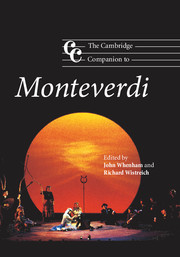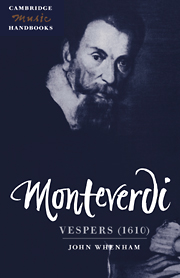33 results
INTERMEDIO V - Magnificat SV281 (1641)
-
-
- Book:
- The Cambridge Companion to Monteverdi
- Published online:
- 28 September 2011
- Print publication:
- 13 December 2007, pp 219-226
-
- Chapter
- Export citation
Preface
-
-
- Book:
- The Cambridge Companion to Monteverdi
- Published online:
- 28 September 2011
- Print publication:
- 13 December 2007, pp xiv-xv
-
- Chapter
- Export citation
Frontmatter
-
- Book:
- The Cambridge Companion to Monteverdi
- Published online:
- 28 September 2011
- Print publication:
- 13 December 2007, pp i-v
-
- Chapter
- Export citation
Chronology
-
- Book:
- The Cambridge Companion to Monteverdi
- Published online:
- 28 September 2011
- Print publication:
- 13 December 2007, pp xvi-xxiii
-
- Chapter
- Export citation
Bibliography
-
- Book:
- The Cambridge Companion to Monteverdi
- Published online:
- 28 September 2011
- Print publication:
- 13 December 2007, pp 299-309
-
- Chapter
- Export citation
Index of titles and first lines
-
- Book:
- The Cambridge Companion to Monteverdi
- Published online:
- 28 September 2011
- Print publication:
- 13 December 2007, pp 339-348
-
- Chapter
- Export citation
Index of names and subjects
-
- Book:
- The Cambridge Companion to Monteverdi
- Published online:
- 28 September 2011
- Print publication:
- 13 December 2007, pp 349-358
-
- Chapter
- Export citation
Notes on contributors
-
- Book:
- The Cambridge Companion to Monteverdi
- Published online:
- 28 September 2011
- Print publication:
- 13 December 2007, pp xii-xiii
-
- Chapter
- Export citation
Dedication
-
- Book:
- The Cambridge Companion to Monteverdi
- Published online:
- 28 September 2011
- Print publication:
- 13 December 2007, pp vi-vii
-
- Chapter
- Export citation

The Cambridge Companion to Monteverdi
-
- Published online:
- 28 September 2011
- Print publication:
- 13 December 2007
Contents
-
- Book:
- The Cambridge Companion to Monteverdi
- Published online:
- 28 September 2011
- Print publication:
- 13 December 2007, pp viii-ix
-
- Chapter
- Export citation
11 - The Venetian sacred music
-
-
- Book:
- The Cambridge Companion to Monteverdi
- Published online:
- 28 September 2011
- Print publication:
- 13 December 2007, pp 199-218
-
- Chapter
- Export citation
List of illustrations
-
- Book:
- The Cambridge Companion to Monteverdi
- Published online:
- 28 September 2011
- Print publication:
- 13 December 2007, pp x-xi
-
- Chapter
- Export citation
The works of Monteverdi: catalogue and index
-
-
- Book:
- The Cambridge Companion to Monteverdi
- Published online:
- 28 September 2011
- Print publication:
- 13 December 2007, pp 314-338
-
- Chapter
- Export citation
Notes
-
- Book:
- The Cambridge Companion to Monteverdi
- Published online:
- 28 September 2011
- Print publication:
- 13 December 2007, pp 280-298
-
- Chapter
- Export citation
4 - ‘Suited to the chapels or chambers of princes’
-
- Book:
- Monteverdi: Vespers (1610)
- Published online:
- 12 January 2010
- Print publication:
- 25 September 1997, pp 41-59
-
- Chapter
- Export citation
Appendices
-
- Book:
- Monteverdi: Vespers (1610)
- Published online:
- 12 January 2010
- Print publication:
- 25 September 1997, pp -
-
- Chapter
- Export citation
Discography
-
- Book:
- Monteverdi: Vespers (1610)
- Published online:
- 12 January 2010
- Print publication:
- 25 September 1997, pp 134-136
-
- Chapter
- Export citation

Monteverdi: Vespers (1610)
-
- Published online:
- 12 January 2010
- Print publication:
- 25 September 1997
Acknowledgements
-
- Book:
- Monteverdi: Vespers (1610)
- Published online:
- 12 January 2010
- Print publication:
- 25 September 1997, pp vii-vii
-
- Chapter
- Export citation



